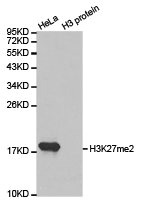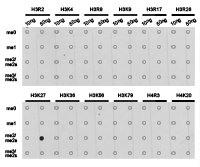
Western blot analysis of extracts of HeLa cell line and H3 protein expressed in E.coli., using H3K27me2antibody.
Histone H3K27me2 Antibody

CSB-PA172810
ApplicationsImmunoFluorescence, ImmunoPrecipitation, Western Blot, ELISA, ImmunoHistoChemistry
Product group Antibodies
ReactivityHuman
TargetH3-4
Overview
- SupplierCusabio
- Product NameHistone H3K27me2 Antibody
- Delivery Days Customer20
- ApplicationsImmunoFluorescence, ImmunoPrecipitation, Western Blot, ELISA, ImmunoHistoChemistry
- CertificationResearch Use Only
- ClonalityPolyclonal
- ConjugateUnconjugated
- Gene ID8290
- Target nameH3-4
- Target descriptionH3.4 histone
- Target synonymsH3 histone family, member T; H3.4; H3/g; H3/t; H3FT; H3t; HIST3H3; histone 3, H3; histone cluster 3 H3; histone H3.1t; histone H3.4
- HostRabbit
- IsotypeIgG
- Protein IDQ16695
- Protein NameHistone H3.1t
- Scientific DescriptionModulation of chromatin structure plays an important role in the regulation of transcription in eukaryotes. The nucleosome, made up of DNA wound around eight core histone proteins (two each of H2A, H2B, H3, and H4), is the primary building block of chromatin (1). The amino-terminal tails of core histones undergo various post-translational modifications, including acetylation, phosphorylation, methylation, and ubiquitination (2-5). These modifications occur in response to various stimuli and have a direct effect on the accessibility of chromatin to transcription factors and, therefore, gene expression (6). In most species, histone H2B is primarily acetylated at Lys5, 12, 15, and 20 (4,7). Histone H3 is primarily acetylated at Lys9, 14, 18, 23, 27, and 56. Acetylation of H3 at Lys9 appears to have a dominant role in histone deposition and chromatin assembly in some organisms (2,3). Phosphorylation at Ser10, Ser28, and Thr11 of histone H3 is tightly correlated with chromosome condensation during both mitosis and meiosis (8-10). Phosphorylation at Thr3 of histone H3 is highly conserved among many species and is catalyzed by the kinase haspin. Immunostaining with phospho-specific antibodies in mammalian cells reveals mitotic phosphorylation at Thr3 of H3 in prophase and its dephosphorylation during anaphase (11). 1. Workman, J.L. and Kingston, R.E. (1998) Annu Rev Biochem 67, 545-79.2. Hansen, J.C. et al. (1998) Biochemistry 37, 17637-41.3. Strahl, B.D. and Allis, C.D. (2000) Nature 403, 41-5.4. Cheung, P. et al. (2000) Cell 103, 263-71.5. Bernstein, B.E. and Schreiber, S.L. (2002) Chem Biol 9, 1167-73.6. Jaskelioff, M. and Peterson, C.L. (2003) Nat Cell Biol 5, 395-9.7. Thorne, A.W. et al. (1990) Eur J Biochem 193, 701-13.8. Hendzel, M.J. et al. (1997) Chromosoma 106, 348-60.9. Goto, H. et al. (1999) J Biol Chem 274, 25543-9.10. Preuss, U. et al. (2003) Nucleic Acids Res 31, 878-85.11. Dai, J. et al. (2005) Genes Dev 19, 472-88.
- ReactivityHuman
- Storage Instruction-20°C or -80°C
- UNSPSC12352203


